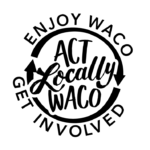By: Clint Weaver, United Way of Waco-McLennan County Board President & 2016 Campaign Chair
Last year, I had the privilege to serve as the United Way Waco-McLennan County Campaign Chair. Currently, I serve as the agency’s Board President. Like so many others, I support our local United Way because of a fundamental belief in the organization’s unique ability to meaningfully impact the most pressing issues facing our community. Consider several statistics that illustrate our challenge.
- 26.5% of McLennan County children live below the Federal Poverty Line
- 24.5% of McLennan County individuals are un-insured
- 19.8% of McLennan County individuals are food insecure
- 49.2 of every 1,000 teens in McLennan County become pregnant
- 478.3 of every 1,000 individuals in McLennan County experience domestic violence
*Source: U.S. Census Bureau
Our local United Way seeks to address these issues and others by harnessing the power of the community one donor at a time. Historically, this has been accomplished through workplace campaigns. Each year, thousands of workplace donors across our community answer the call to help their neighbor. These women and men, by generously giving a portion of each paycheck, are the life-blood of the annual United Way campaign. Last year, workplace donors enabled our local United Way to contribute nearly $2,000,000 toward programs accomplishing the following:
- 20,549 low-income McLennan County children received access to Early Childhood Education Classes, and quality afterschool and summer school programs.
- 33,753 low to un-insured families and individuals in McLennan County received access to medical pre-screenings, health exams, prescription assistance, and physical, emotional, and mental therapy.
- 150,498 meals and bags of groceries were provided to children, families, and individuals in McLennan County living below the Federal Poverty Line.
- 4,602 low-income pregnant girls and women in McLennan County received access to prenatal care, resource assistance and post-pregnancy parenting classes.
- 22,344 families and individuals experiencing family crisis and domestic violence received access to shelter, resources, counseling, and case management.
Last year, over 41,000 McLennan County families benefited from United Way funded programs. As evidenced by these statistics, a gift from one individual, when pooled with donations from co-workers and neighbors, has the ability to positively impact thousands of lives. This is the purpose of the United Way: to unite multiple individual donors and leverage their collective resources to generate lasting impact in the community. Generations have been made stronger, more self-sufficient, and have risen above poverty’s limitations because of the collective might of work place donors.
For nearly 90 years, United Way of Waco-McLennan County has focused on strengthening our community and creating opportunity for every citizen through inspired and informed philanthropy. All too often, people equate philanthropy with great wealth and large donations. My experience with last year’s campaign opened my eyes to the main street philanthropy that occurs around us each day. Without public recognition or fanfare, work place donors continually, year-after-year, provide the resources needed to support their neighbors in need. These are the philanthropists who empower our work and truly exemplify what it means to live united. I am humbled by their steadfast belief in our mission. On behalf of the United Way of Waco-McLennan County board and staff, our United Way funded agencies, and the thousands of lives positively impacted each year, I say thank you to these amazing women and men for the difference they make in our community. I am #ProudToLIVEUNITED.
 A financial advisor since 2006, Clint joined Stifel in 2014. Clint makes it a priority to place his clients’ interests first and use his knowledge and experience to continually adapt to their rapidly changing industry. Clint’s community involvement includes serving on the Executive Board and Foundation Board for the United Way and on the boards of the Heart O’ Texas Fair and Rodeo and the REACH Therapeutic Riding Center. He is a member of the First Baptist Church of Waco and is active in the Baylor Bear Foundation. Clint and his wife, Casie, have two children: Jack and Tessa.
A financial advisor since 2006, Clint joined Stifel in 2014. Clint makes it a priority to place his clients’ interests first and use his knowledge and experience to continually adapt to their rapidly changing industry. Clint’s community involvement includes serving on the Executive Board and Foundation Board for the United Way and on the boards of the Heart O’ Texas Fair and Rodeo and the REACH Therapeutic Riding Center. He is a member of the First Baptist Church of Waco and is active in the Baylor Bear Foundation. Clint and his wife, Casie, have two children: Jack and Tessa.
By Dasjaevian Dixon
Searching for a job or an internship can be a tedious process. But researching and making genuine connections can help to ease that process. Last year, I utilized Eagle Network as a vital resource to find the Disney College Program internship, which is available for all students at the University of North Texas.
Eagle Network is an excellent resource for finding jobs, internships, and shadowing opportunities. After I found out about the Disney College Program, I researched the company and what it has to offer – not only to potential employees but for the millions of guests from all over the world who visit Walt Disney World annually. My excitement began once I learned that Disney was a Fortune 500 company that places great emphasis on guest satisfaction and opens doors for its interns’ occupational growth. After reading these descriptions, I knew the company would be a great fit for me.
I followed up with Disney’s recruitment team after applying to make sure an interview was secured. The interview lasted about 20 minutes. I was excited about the big break afterwards, but nervous regarding what to expect. After the over-the-phone interview, I sent a follow-up email expressing how thankful I was to even have the chance to be interviewed by a Disney recruiter.
I highly encourage all students to take advantage of resources offered from your school. Every interview will not be great. Every job you apply for will not be handed to you. However, you must stay persistent. Keep putting forth an effort to build and gain employment skills that will be vital to your eventual career of choice.
A great tool I would recommend in helping your job/internship search is LinkedIn. This unique social network for employers can mark the difference between an overlooked candidate and potential hire. I recommend using LinkedIn to reach out to as many professionals as possible.
My internship was a great learning experience overall, as well as a lot of fun. At the same time, I began it with several challenges – some of which came from simply adjusting to it. But that’s a part of every process, right?
It was difficult adjusting financially and physically when I arrived in Orlando, Florida, in April. It was also challenging to maintain a new schedule. Plus, I only had $300 dollars to my name. I had to use Uber numerous times to get around until I found someone who could provide transportation. Although most of my destinations were nearby, the money I spent on Uber accumulated quickly.
My normal routine consisted of attending classes, working, exercising, and socializing. That didn’t work out so well for the first 6 weeks of the internship. Before I knew it, I was working about 45 hours a week while taking 2 online classes through UNT. I couldn’t work out or socialize as much as I wanted to.
Working 6 days a week for about 2 months made me embrace time management more than I ever have. As much as it made me find a balance, it motivated me to improve my health to endure the long work days. I started cooking breakfast every morning and taking vitamins which helped tremendously. In return, I could get through the week without being so fatigued.
One thing I really looked forward to was volunteering alongside the Make-A-Wish Foundation as a wish granter. I knew Disney had a close partnership with the foundation, and I wanted to utilize that as a way to give back to the community.
Before passing away in July of 2007, my younger sister made a wish to attend a Ne-Yo concert while recovering from our bone marrow transplant. Her immune system was not strong enough for traveling, so Make-A-Wish made a way for her to attend a WWE event in San Antonio, Texas instead. She had the time of her life meeting some of her favorite wrestlers – especially her favorite, John Cena. He currently grants many wishes for children with life-threatening medical conditions.
I had my own chances to help grant wishes for 2 children in the Orlando area – in May and June respectively. Both of the families I interacted with were genuinely happy that their child would do something fun to aid them through challenging turmoil. Fortunately, I left both families’ homes feeling like I was a part of their units. It has been a wonderful experience being a part of the world’s largest wish granting organization. I look forward to continuing to serve in the North Texas region.
I’ve developed genuine relationships with people worldwide. Interacting and learning about different cultures with the international students I worked with was a blast. It strengthened my comprehension of how to communicate and made me eager to visit different countries.
At work, I was able to network with many people from different backgrounds. I did my best in making sure that guests felt comfortable and welcomed whenever they visited our store. I had the opportunity to engage in meaningful conversations that I will remember for the rest of my life. Throughout my internship, I interacted with thousands of guests and I am now more comfortable when speaking to large audiences or individuals that I’m meeting for the first time.
As a young professional, I’ve sharpened valuable skills which make me an important asset in the business field. Some of those skills include being personable, practicing effective communication, identifying problems, and providing ample solutions. Now, I can find a perfect balance between hard work and participating in extracurricular activities.
Most importantly, I still enjoyed the recreational activities Walt Disney World offered. On my off days, I visited theme parks and traveled around Florida. Being in this enlightening atmosphere every day has inspired me to continue working hard and enjoying the treasures of life. I am beyond thankful for this opportunity and experience. Thank you and best regards to everyone who continues supporting and encouraging me on this formative professional journey.
 Dasjaevian Dixon is an undergraduate student at the University of North Texas studying Marketing with a double minor in Decision Sciences and Psychology. He is currently interning at Walt Disney World in Orlando, Florida. Dasjaevian is a Brazos Education Foundation scholar. He currently serves as the Vice President for The Presidential Men, an organization he helped implement at UNT. He also assists with helping grant the wishes of children with life-threatening medical conditions for the Make-A-Wish Foundation. Owning his own business in the future is one of his top goals. As a millennial, he is building on his personal and professional skills to become a valuable asset in the business field.
Dasjaevian Dixon is an undergraduate student at the University of North Texas studying Marketing with a double minor in Decision Sciences and Psychology. He is currently interning at Walt Disney World in Orlando, Florida. Dasjaevian is a Brazos Education Foundation scholar. He currently serves as the Vice President for The Presidential Men, an organization he helped implement at UNT. He also assists with helping grant the wishes of children with life-threatening medical conditions for the Make-A-Wish Foundation. Owning his own business in the future is one of his top goals. As a millennial, he is building on his personal and professional skills to become a valuable asset in the business field.
The Act Locally Waco blog publishes posts with a connection to these aspirations for Waco. If you are interested in writing for the Act Locally Waco Blog, please email ashleyt@actlocallywaco.org for more information.
by Carrie Arroyo
Summer is my time to relax, eat too much ice cream, run through the sprinkler in the front yard with my kids, and watch the hummingbirds eat from our Turk’s Cap off the front porch. But because I work on a school calendar schedule and have 3 youngsters who will all be in school this fall, it is impossible to escape the inevitable hanging over our heads: school is only 1 month away! Sorry to bring it up and crush your dreams of endless fire fly chasing at dusk, but I do have some suggestions that will help ease the transition back in to school and contribute to a successful school year for kids, families, and teachers alike.
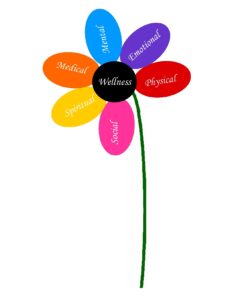 We would love to silo academic success as only being influenced by the amount of study time, quality of textbooks and teaching skills, and intellectual capacity. But the reality is that it is also directly influenced by our physical, mental, and social well-being. Our mental wellness is a key component to achieving academically. Wellness requires the active pursuit of health instead of treatment of illness. When we build wellness practices in to our lives, we are building up our reservoir of mental resources so that when stressful and challenging times hit, we have an ample supply of mental energy and flexibility to withstand added demands. Mental wellness also helps us to flourish in our daily lives. And if we want our children to succeed and flourish in school, there are few things we can do to help them pursue mental wellness. (flower)
We would love to silo academic success as only being influenced by the amount of study time, quality of textbooks and teaching skills, and intellectual capacity. But the reality is that it is also directly influenced by our physical, mental, and social well-being. Our mental wellness is a key component to achieving academically. Wellness requires the active pursuit of health instead of treatment of illness. When we build wellness practices in to our lives, we are building up our reservoir of mental resources so that when stressful and challenging times hit, we have an ample supply of mental energy and flexibility to withstand added demands. Mental wellness also helps us to flourish in our daily lives. And if we want our children to succeed and flourish in school, there are few things we can do to help them pursue mental wellness. (flower)
5 Tips for Increasing Mental Wellness at School
1. Focus on learning over perfection. My 9-year-old is wired in such a way that he hates to try something new unless he is 100% sure he is going to be able to master it quickly. One of the first times this became obvious was when he was learning to tie his shoes when he was 4. In an effort to get him to persist in this new and challenging task, we mandated mistake-making. He was required to make at least 5 mistakes and we celebrated wildly with claps, cheers, and dance parties every time he messed up. This made him laugh and loosen up and be willing to keep trying (and keep messing up) until he mastered the task. The focus in school performance too easily becomes the grade that comes home on the paper or report card. Instead of rewarding or punishing the grade, focus on rewarding and reinforcing the learning. We need to cultivate this culture and build in an expectation of curiosity and experimentation that feeds creativity. Kids need to know that they are safe to make mistakes and that the classroom and their families will still accept them and appreciate them for what they bring to the learning process.
2. Connection, Belonging and Trust. As much as teachers would like to think it’s true, very few students wake up excited to go to school in order to learn a new algebra equation. When I ask my kids about their most memorable moments of the school day, they usually center around an interpersonal interaction. Whether it was a game they played on the playground with friends or a hug they received from their teacher, they feel energized by points of connection throughout the day. These moments of attention to who they are as individuals and appreciation of their presence, are little deposits in to the mental wellness bank. And when they are feeling positive about themselves and their school environment, their ability to learn that new math fact increases exponentially.
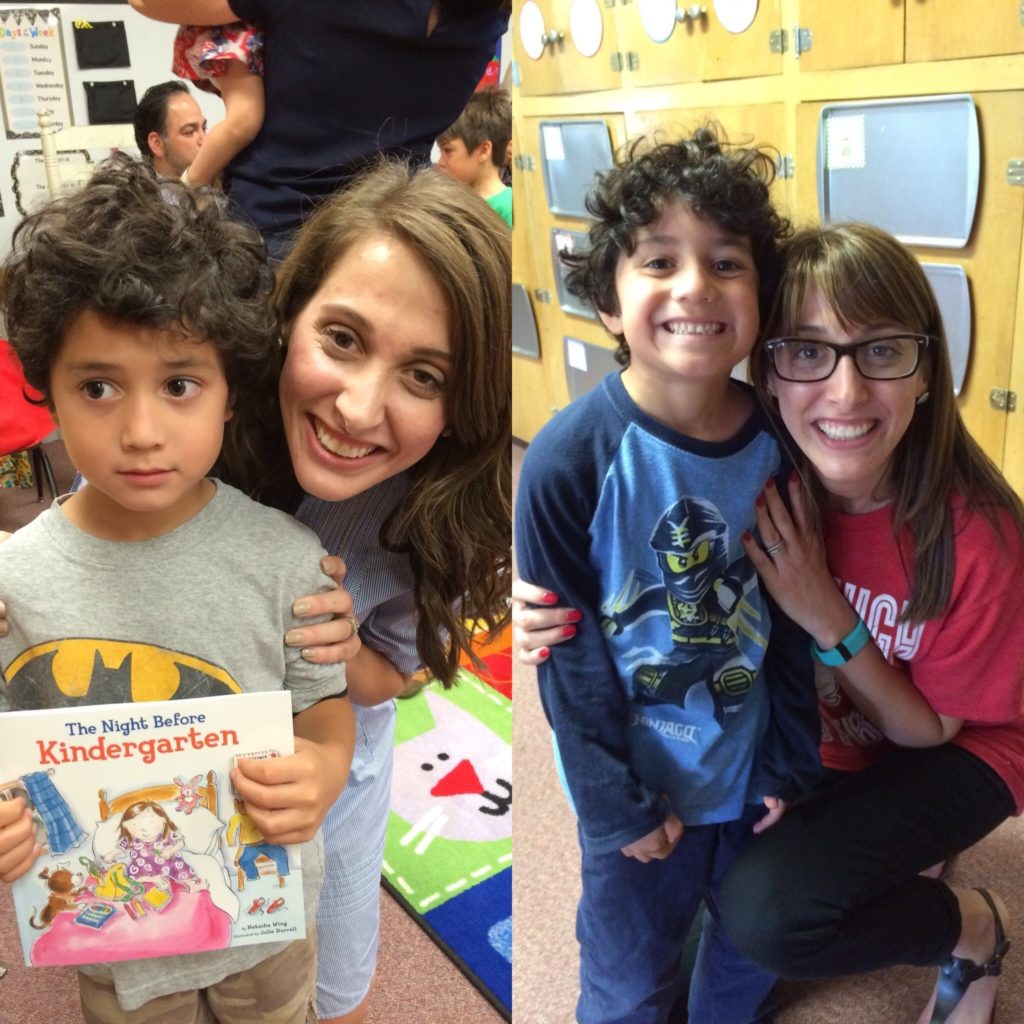
Picture of my son Ezekiel and his Kindergarten teacher Mrs. Draper on the first (left) and last (right) day of school in 1st grade. From fear and apprehension, to love, acceptance, and success!
3. Be Proactive and Limit Surprises. I love a good surprise. One of my biggest pet peeves is someone telling me the ending of a book or movie before I have had the chance to experience it myself. However, there are some situations where limiting surprises can help our minds, hearts, and spirits to thrive; and school is one of these situations. For families, be proactive and visit your child’s school ahead of time: meet key people, find the cafeteria and bathrooms, walk your class schedule before bells are ringing and other people are bumping in to you. For schools, minimize complications for families and students: have clear signs and make sure procedures are easy to find and follow. Streamline things as much as possible. Clear and consistent communication helps to clear up a multitude of misunderstandings and can make the school environment much more inviting to students and families. So caregivers, don’t stop surprising kids with unexpected notes of encouragement in their lunch boxes such as “Good luck on your science test” or “I hope you have a great day” and teachers, don’t stop giving the surprise gift of dropping the lowest test grade at the end of the grading period, but also make sure you give plenty of information and guidance up front to demystify the experience.
4. Routine helps children’s brains navigate the world. As they experience new things, their brains sort the information, assimilate it in to their thinking process, and adapt and grow as they learn new things. Providing structure to a child’s day helps them to thrive. This starts at home before they come to school with adequate sleep, a good morning greeting, and a hug before they walk out the door. Building in routines that give attention to physical needs is also directly tied to mental wellness. Kids need to eat well, be sufficiently hydrated, and get some exercise. Moving the body can do wonders for opening up the mind and being ready to learn. Building brain breaks in to the routine keeps the mind flexible and responsive to the learning environment.
5. Focus on what works. The ‘power of positive thinking’ is not just an old phrase; it is actually helpful to build up our mental wellness. Our brains tend to repeat the things that we focus on the most. If we are constantly focusing on what a child has done wrong and giving attention to it, it is actually more likely to increase. Telling kids what we want to see and encouraging positive behaviors increases the likelihood of positive behavior and habits. When something goes wrong, offer the child the opportunity to redo a mistake. I know this can be hard for those of us who grew up thinking the best way to train a child is to be hard and strict with more of a “get it right the first time or else” approach. But what we know from research is that we remember what we do – whether that is doing it wrong or right. Take the time to give a child the opportunity to redo an action they originally got wrong so that their motor memory can store the right way to do it. It will increase the likelihood that they will get it right the next time. Yes, it takes time, but is time well spent. And at the end of it, the adult and child are both celebrating a success rather than fuming over a mistake. This builds a more connected and collaborative relationship by increasing positive thoughts and feelings.
 Carrie Arroyo works hard as a Lecturer in the Diana R. Garland School of Social Work at Baylor University where she teaches soon-to-be social workers and coordinates the BEAR (Be Emotionally Aware and Responsive) Project with Waco ISD. She also plays hard as a mom of 3 energetic kids: Jonas (9), Ezekiel (7) and Eden (4) and wife to Fernando in their North Waco neighborhood.
Carrie Arroyo works hard as a Lecturer in the Diana R. Garland School of Social Work at Baylor University where she teaches soon-to-be social workers and coordinates the BEAR (Be Emotionally Aware and Responsive) Project with Waco ISD. She also plays hard as a mom of 3 energetic kids: Jonas (9), Ezekiel (7) and Eden (4) and wife to Fernando in their North Waco neighborhood.
(Tami Nutall Jefferson, a married mother and grandmother, is going back to school and she has invited us all along to enjoy the ride. For more posts in this series, click here: Tami’s Big Do Over. – ABT )
By Tami Nutall Jefferson
Whether you’re reciting the opening of Hamlet’s soliloquy – “to be or not to be” – or humming Black Sheep’s hook inside your head – “you can get with this or you can get with that” – the bottom line always comes down to ‘WHY?”
Why is being this better than being that? Why is doing this better than doing that? For me, the “why” was “why go back to college, at all, at this point in my life?”
Flashback — It’s Me
Last year, I read an article about this 50-something year old person who spent their lifetime transforming themselves from a man into a woman. In the end, they were ravaged emotionally and physically and a shell of their real self. The one thing they lamented was how, throughout their whole journey, no one had ever asked them why they were doing what they were doing. All he/she got was support.
In preparing for this conversation with you this month, I realized I, too, have been that person. The person that everyone trusted to make her own best choices. Everyone I knew, pretty much always supported me. No one ever really questioned or challenged me or my “why.” I always thought it was a blessing. Now I’m reconsidering.
Unlike ever before, when it comes to going back to school, everyone has started asking me “Why?” Almost all of my friends and business associates – even my own husband – everyone is asking me “why?”
I have been answering the incessant “why” question for the last 6 months. For the first time in my life, I have to defend my “why.” It was easy to defend it to myself in February when I first asked myself the question. “Because this is what I’ve always wanted to do and because this is what I came back to Texas in 2011 to do. So I’m doing it.” But on the other side of 30, you somehow loose the privilege of having “I don’t know” and “Because I want to” as your reasons “why” for doing almost anything.
No One Wants a Weak Why
I have invested over a hundred hours the last few months going through my old journals and goals lists, the TAMU course catalog and syllabi, professor CVs, advertised industry job descriptions, and the like. I have accumulated a paper ream of goals and plans written out over the years that all pretty much say the same three or four things. All of this, to get to my “why.” Through the practice of researching my ‘Why?’ I went even farther and took time to research the objects of my affection. It’s one thing to really want something or whatever your “why” is. It’s a whole other thing to really count the cost of being, doing, and having that thing. You might find that your “why” is not strong enough to withstand the test of living and – in Silicon Valley terms – you might have to pivot.
Tami’s Choice
I planned on studying real estate development, urban planning, AND economic development and having a career doing all three. I began to ask myself, “In light of the fact that I can only take a limited number of elective credits, why do I REALLY want to take each of these subject matters instead of focusing on one specific one? Furthermore, what does each job truly entail?”
I read at least 50 job listings and resumes for these professions, as well as their respective trade associations and certification webpages. Conclusion – These are three completely different jobs with three completely different skill sets done by three completely different types of people. I’m only one of me! I can’t effectively do them all. I have to choose. So how do you choose? My life experience tells me if I go with choice B or C, then I’m always going be to distracted from my work and trying to figure out how I can jump the fence to choice A. I don’t have another 20 years to chase choices B, C, D, or Z. My time is now – or never, to be totally honest with myself. Researching and answering this hard “why” question has set me on a more attainable path with regard to my major and minor courses, my capital, my professional relationships, business endeavors, and so on. I essentially saved myself thousands of wasted hours and dollars, and secured my future Level 10 happiness. I pivoted – and it was okay. It was actually empowering. And my resolute “WHY” grew just a little bit more.
It’s The Big One
That’s great. But that still leaves the big WHY? unanswered. Why go to college in the first place? Every student has to answer this question – whether they’re 17 or 70. Often we ask it of ourselves as we’re pouring over some inane text at 2:00 am. This is where the “21 reasons why” come rolling out of my mouth. My “whys” range from the technical – learning more so I can earn more, to the passionate – my childhood dream, to the practical – I don’t want to be dumbed out of the future workforce. But as I look at them, there is no one Big Why. My “why” is like a pie, it takes many pieces to make up a whole one. There is no perfect blanket answer that will appease every asker. But if I know anything about life, it’s that any one of my 21”whys” will smack me square in the face when I’m faced with its opposition. Like a time, when I see the perfect job posting with educational requirements. Or if I should travel to Greece and see the hotelier’s TAMU degree on their office wall. Or when…
No matter what the occasion, audience, or location, my “why” has to be resolute, well-researched, and able to stand up to the caring people who ask and the dissident people who oppose it. That is something you don’t learn when everyone in your life, for your whole life, just blindly supports you without ever sincerely questioning you. That is something I’m learning now, and it’s something that I know will make me a strong leader.
And The Beat Goes On
I’ve been struggling all day with how to wrap this up in a nice, little bow. A well-versed conclusion. And I finally realize, as deadline approaches fast, there is no conclusion. This is the beginning. I’m only at the beginning of learning my “whys” and having them be real to me. I have 5 semesters to go and I’m excited to see what “whys” they will bring up. Especially that first semester. So until next time…
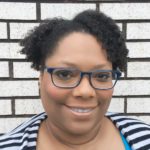 Tami Nutall Jefferson has over a decade of experience in real estate sales and management and currently works as a home and building designer. This Fall she will begin her first academic year at Texas A&M University pursuing a Bachelor’s Degree in Urban Planning and Real Estate Development while commuting between Waco and College Station. Her hope is that Waco becomes the most attractive, modern, vibrant, and prosperous version of itself as an inclusive city and her professional mission is to help make that happen. Tami is also a 2017 graduate of the Leadership Plenty Institute and volunteers her time and voice to many downtown Waco placemaking and economic development causes and organizations.
Tami Nutall Jefferson has over a decade of experience in real estate sales and management and currently works as a home and building designer. This Fall she will begin her first academic year at Texas A&M University pursuing a Bachelor’s Degree in Urban Planning and Real Estate Development while commuting between Waco and College Station. Her hope is that Waco becomes the most attractive, modern, vibrant, and prosperous version of itself as an inclusive city and her professional mission is to help make that happen. Tami is also a 2017 graduate of the Leadership Plenty Institute and volunteers her time and voice to many downtown Waco placemaking and economic development causes and organizations.
To engage and share your non-traditional student experiences with Tami, contact her at taminutall@gmail.com or connect with her on Facebook https://m.facebook.com/tami.nutall1
By Rachel E. Pate
2017 has seen a summer filled with action-packed heroic blockbusters. From Wonder Woman and Spiderman to the Justice League and Guardians of the Galaxy, there’s a big screen hero for each one of us. I recently watched the new Power Rangers movie and was transported back to my childhood, embracing every character and rooting for the heroes. There was one scene, however, that despite all the movie majesty just didn’t play to my adult sensibilities.
Spoiler alert…
It’s the scene in which Billy, the quirky super-smart blue ranger, was tragically drowned by the evil villainess Rita – who, by the way, was quite a bit more fierce than her predecessor on the original television show. The remaining rangers pulled his lifeless body from the water; they laid him on his back and looked on hopelessly at his motionless frame. That’s when the “adult alarm” sounded in my head, and I immediately questioned why no one attempted to perform CPR on Billy. This sad situation in the movie was eventually rectified by their great and mighty mentor Zordon, but real-life heroes have only seconds to think and react. The first responders of the community, our firefighters, law enforcement and emergency medical personnel, save lives daily with sometimes only moments to spare.
On Saturday, July 8th between the early morning hours of 3 a.m. and 4 a.m., an unnamed hero sprang into action to save a fellow citizen. Curtis Jefferson of Rockford, IL, was staying at a Waco-area hotel and was headed through the lobby when he said he witnessed two patrons, a man on crutches and a woman, administering CPR to the front desk attendant. The manager had suffered an apparent heart attack while assisting the customers and the gentleman on the crutches leapt over the desk to perform life-saving measures. The two patrons were able to provide aid to the hotel employee until the ambulance and paramedics arrived. In Mr. Jefferson’s words, “The (male) patron saved his life by performing CPR.” It was in speaking with the female patron afterwards that Mr. Jefferson learned that the mysterious man on crutches was in fact a trained first responder, a firefighter paramedic, and he’d vanished after all the commotion died down without any hoopla or cheering fans. He simply did what needed to be done and moved on.
There are tons of local heroes who suit up daily to battle real world crises; burning blazes, horrific accidents, medical emergencies and more. Often times, their stories go unannounced and these heroes return home after work to manage their lives as ordinary citizens. They deserve our support and thanks.
They are due our appreciation for their willingness to answer the call whether on-duty or off.
They are actually due much more than our gratitude, but we can offer at least that. The Cen-Tex African American Chamber of Commerce will host its first We Say Thanks- First Responder Appreciation Event on Tuesday, July 25th from 5 p.m. to 7 p.m. at Hilton Home2 Suites located at 2500 Bagby Avenue in Waco. The event will feature local first responders and include networking and catered refreshments.
 Rachel E. Pate is a native Wacoan and 1999 graduate of University High School. She currently works as the Public Relations person for the Cen-Tex African American Chamber of Commerce and serves as Coordinator for the Esther’s Closet program for women. She’s also a proud mom of one, lifelong member of Toliver Chapel (TCMBC) Church, lover of the great outdoors, avid sports fan and dedicated wearer of Converse’s Chuck Taylor shoes.
Rachel E. Pate is a native Wacoan and 1999 graduate of University High School. She currently works as the Public Relations person for the Cen-Tex African American Chamber of Commerce and serves as Coordinator for the Esther’s Closet program for women. She’s also a proud mom of one, lifelong member of Toliver Chapel (TCMBC) Church, lover of the great outdoors, avid sports fan and dedicated wearer of Converse’s Chuck Taylor shoes.
The Act Locally Waco blog publishes posts with a connection to these aspirations for Waco. If you are interested in writing for the Act Locally Waco Blog, please email ashleyt@actlocallywaco.org for more information.
by CeRon Ford
Cheeseburgers and French fries have you down in the gutter? Tired of paying for expensive salads at drive-thru restaurants? Do you want to work out but not sure where to go? No need to waste any more time searching for the most affordable salad or settling for just any gym– we have everything mapped out just for you!
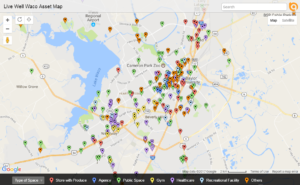 Ever heard of the Live Well Waco (LWW) Asset Map? No? Well, you may want to pay close attention to this. Live Well Waco is a coalition dedicated to improving the health of people living, working and playing in McLennan County. The Live Well Waco Coalition began more than 5 years ago as a collaborative effort between community businesses, organizations, and individuals who are dedicated to the health of McLennan County residents. LWW focuses on improving area health disparities by hosting events such as community cooking demonstrations, physical activity programs, and more. The Live Well Waco Leadership team created the asset map to promote a better understanding of diversity within the community while helping community members locate fresh produce and healthy foods, exercise facilities, healthcare facilities, and other local resources.
Ever heard of the Live Well Waco (LWW) Asset Map? No? Well, you may want to pay close attention to this. Live Well Waco is a coalition dedicated to improving the health of people living, working and playing in McLennan County. The Live Well Waco Coalition began more than 5 years ago as a collaborative effort between community businesses, organizations, and individuals who are dedicated to the health of McLennan County residents. LWW focuses on improving area health disparities by hosting events such as community cooking demonstrations, physical activity programs, and more. The Live Well Waco Leadership team created the asset map to promote a better understanding of diversity within the community while helping community members locate fresh produce and healthy foods, exercise facilities, healthcare facilities, and other local resources.
The asset map includes a list of locations that provide access to healthy living opportunities all within the City of Waco. With the LWW Asset Map, we want to help protect and conserve the local traditions, customs, and resources that are prevalent in Waco, Texas.
Maps can often be tricky, but the best way to learn is just to dive in!
Here’s the link: www.batchgeo.com/map/livewellwaco
And here are some tips for using it! :
Use the drop-down box located in the bottom left hand corner to select the category that you want to search. The 4 categories are type of space, quality, neighborhood, and amenities. To narrow down the locations shown in the map, you can select one group or multiple groups shown as the colorful circles to the right of the drop down box. For example, “Type of Space” would be the category, and “Store with Produce, Agency, and Public Space” would be considered groups. You can further target your search or search by other criteria by changing the category from the drop down box and selecting additional groups to the right of the box. As you select the groups, they appear in gray boxes, and if you want to delete a selection, just click the “X” on the left hand side of the gray box.
Here is what you will find within each category.
Type of Space:
- Stores with produce- includes grocery and convenience stores
- Agency- social service agencies
- Public Space- free space for exercise such as parks
- Gym- locations of gyms to engage in physical activity
- Healthcare- locations to access health screenings or vaccinations
- Recreational Facility- locations of community centers
- Other- locations that do not fit into the previous categories such as libraries where access to a computer is available
Quality:
- Healthy Living- includes locations for accessing healthy lifestyles
- Healthy Eating- includes locations with fresh produce or healthy food options
- Active Living- includes locations that offer free or low cost opportunities to exercise
Neighborhood: If applicable, the locations are broken into which neighborhoods the assets are located. For example: Lacy Lakeview, Kendrick, Bellmead, University, Waco and Others.
Amenities: If available, different assets are listed such as locations where playgrounds are located. For example: Playgrounds, outside fields, Library, fresh produce, school w/ playground, Playgrounds and Others.
The colorful circles on the map represent the groups within the different categories you have selected, which is shown in the image below. Click on a circle inside the map to see detailed information about the location. To look at another location click the “X” on the right hand side of the box or simply click on another circle.
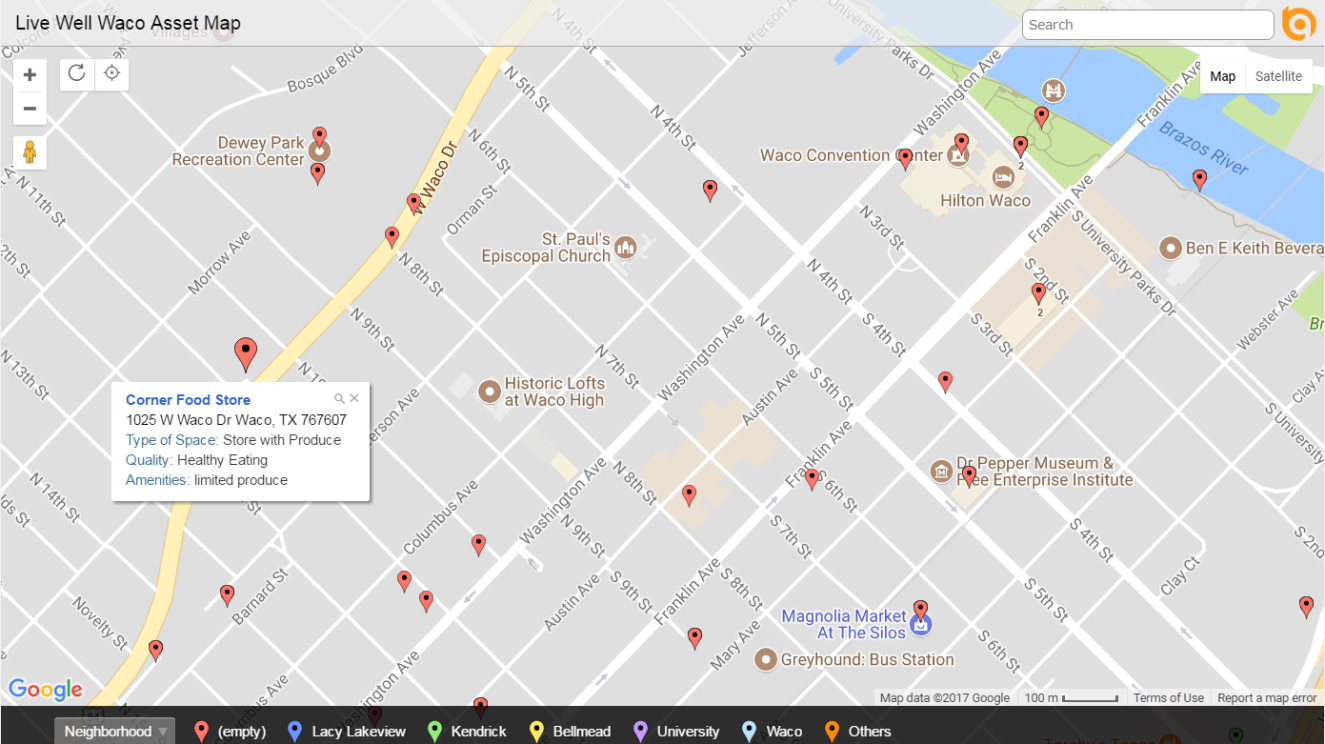
To view a list of all the locations shown on the map, first, make sure your cursor is not hovering over the map and then scroll down the page. Under the black square you will see the locations itemized in a list format. This list will change as you select specific categories and groups. You can also use the scroll bar located on the right hand side of the page.
To zoom in and out of a specific area on the map: (1) Use the + and – signs located on the left hand side of the map (2) Click on the map in the area with the circles and use your mouse to scroll forward to zoom in or backwards to zoom out.
The Live Well Waco Asset Map is an awesome tool that helps providers and community residents identify assets and strengths around the community. Types of resources are clearly and easily categorized into stores with produce, local agencies, public spaces, gyms, healthcare facilities and recreational facilities across the great City of Waco, Texas. The LWW Asset Map can save you time and money as well as improve your quality of life, so let’s SHARE it! By promoting the LWW Asset Map tool within local clinics, doctor’s offices, local food banks, and through other local organizations, we can provide this asset map as a public service to the entire community so that patients, clients, and partners can support and encourage one another to make healthier lifestyle choices. The LWW Asset Map is already linked to the Live Well Waco website, but the opportunity to spread awareness of this great resource on other organizations’ and partners’ websites will go a long way.
The Asset Map tool not only provides a visual representation of local businesses and resources, but it also provides valuable information that will ultimately help all community residents lead a healthier lifestyle. The time to improve healthy eating and increase physical activity is NOW! Let the Live Well Waco Asset Map guide you to health and success! Although the journey is not easy, Live Well Waco Coalition challenges you to take the highway and merge into a healthier lifestyle!
 CeRon Ford moved to Waco in August 2013 to attend Baylor University. He received his Bachelors of Science in Public Health, and had the opportunity to intern at the Waco-McLennan County Public Health District as a Live Well Waco intern during his final summer in Waco. CeRon will further his efforts of pursuing public health by attending Morehouse School of Medicine’s Master of Public Health Program in Atlanta, Georgia, In the Fall 2017.
CeRon Ford moved to Waco in August 2013 to attend Baylor University. He received his Bachelors of Science in Public Health, and had the opportunity to intern at the Waco-McLennan County Public Health District as a Live Well Waco intern during his final summer in Waco. CeRon will further his efforts of pursuing public health by attending Morehouse School of Medicine’s Master of Public Health Program in Atlanta, Georgia, In the Fall 2017.
The Act Locally Waco blog publishes posts with a connection to these aspirations for Waco. If you are interested in writing for the Act Locally Waco Blog, please email ashleyt@actlocallywaco.org for more information.
For many years, Sanger Avenue Elementary School stood as the most familiar landmark of the Sanger Heights neighborhood. Located in the “Silk Stocking District,” Sanger Avenue Elementary acquired a reputation as one of the premier educational institutions in the city.
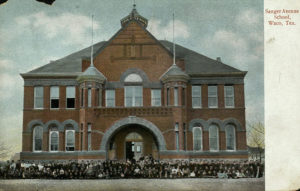 A 1903 bond election resulted in the construction of three nearly identical schools. Sanger Avenue School, designed by renowned Waco architect Milton W. Scott, long outlasted its counterparts Bell’s Hill and Brook Avenue Elementary Schools. The two-storied building featured unique architecture and elaborate design, including ornate arches, a rotunda, an upstairs auditorium, and a high roof crowned by a cupola. The building’s heavily Romanesque style included arched windows and doors framed by limestone. Prominently featured turrets stood at the front of the original school building but were removed in a 1930 renovation.
A 1903 bond election resulted in the construction of three nearly identical schools. Sanger Avenue School, designed by renowned Waco architect Milton W. Scott, long outlasted its counterparts Bell’s Hill and Brook Avenue Elementary Schools. The two-storied building featured unique architecture and elaborate design, including ornate arches, a rotunda, an upstairs auditorium, and a high roof crowned by a cupola. The building’s heavily Romanesque style included arched windows and doors framed by limestone. Prominently featured turrets stood at the front of the original school building but were removed in a 1930 renovation.
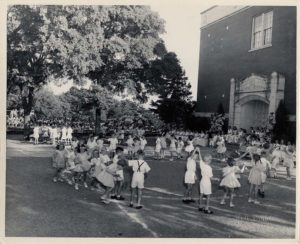 Sanger Avenue School opened in 1904 with John H. Richardson as its first principal. Former students and teachers generally agree that the most influential figure in the history of Sanger Avenue was likely Nina Glass, the school’s second principal. Glass encouraged parents and students to take an active role in education, establishing a mimeographed newsletter for parents called the Ginger Jar and inviting students to save coupons to buy pictures for the school. She published a nationally used arithmetic textbook and frequently attended educational conferences. Well liked by both staff and students, Glass was often seen at the school’s annual May Fete festival, brightly garbed and leading students in a parade around the Maypole.
Sanger Avenue School opened in 1904 with John H. Richardson as its first principal. Former students and teachers generally agree that the most influential figure in the history of Sanger Avenue was likely Nina Glass, the school’s second principal. Glass encouraged parents and students to take an active role in education, establishing a mimeographed newsletter for parents called the Ginger Jar and inviting students to save coupons to buy pictures for the school. She published a nationally used arithmetic textbook and frequently attended educational conferences. Well liked by both staff and students, Glass was often seen at the school’s annual May Fete festival, brightly garbed and leading students in a parade around the Maypole.
Glass’s enthusiasm reflected the general atmosphere at Sanger Avenue Elementary. Former students fondly remember dedicated teachers and classrooms ideally suited for learning. Large windows poured light into classrooms where each student’s cast-iron and wooden desk held an inkwell. A spacious and well-stocked library, established after Glass attended a Chicago educators’ conference, invited students to study and read.
The years following Glass’s retirement from Sanger Avenue brought great changes for the small elementary school. By the 1960s, over seven hundred students attended the school, and music classes and a choir were established. Yet the Waco Independent School District (WISD) announced plans for the school’s closure as a part of a busing plan to meet a federal desegregation order. By the 1970s, African American students made up approximately half of the school’s population. Despite the efforts of many to keep the school open, classes ceased at Sanger Avenue in 1974.
Although a portion of the school briefly housed a Head Start program, much of the building soon suffered from years of disuse. Disappointed at seeing such an important piece of Waco’s history sit vacant, Waco attorneys LaNelle and John McNamara purchased the school for $80,000 from WISD. The couple renovated the building, installing a new roof, boarding up broken windows, and removing asbestos. Yet despite their hopes of repurposing the building, perhaps as a charter school, the plans never came through. Another blow was dealt to the historic building when arsonists set fire to it in 2008.
The city of Waco deemed the building unsafe, and in 2010 bulldozers tore the remnants of the structure down, leaving only the entrance archway standing. The school’s former location has been featured in the Waco Trib recently as a possible location for an indoor soccer field.
Cite this Page:
Karen Green and Cheryl Wiggington, “Sanger Avenue Elementary School,” Waco History, accessed July 19, 2017, http://www.wacohistory.org/items/show/112.
 Waco History is a mobile app and web platform that places the past at your fingertips! It incorporates maps, text, images, video, and oral histories to provide individuals and groups a dynamic and place-based tool to navigate the diverse and rich history of Waco and McLennan County. It is brought to you by the Institute for Oral History and Texas Collection at Baylor University. This post: Prisca Bird, “Lovers’ Leap,” Waco History, accessed June 21, 2017, http://www.wacohistory.org/items/show/38.
Waco History is a mobile app and web platform that places the past at your fingertips! It incorporates maps, text, images, video, and oral histories to provide individuals and groups a dynamic and place-based tool to navigate the diverse and rich history of Waco and McLennan County. It is brought to you by the Institute for Oral History and Texas Collection at Baylor University. This post: Prisca Bird, “Lovers’ Leap,” Waco History, accessed June 21, 2017, http://www.wacohistory.org/items/show/38.
The Act Locally Waco blog publishes posts with a connection to these aspirations for Waco. If you are interested in writing for the Act Locally Waco Blog, please email ashleyt@actlocallywaco.org for more information.
By Bethie Timmons
The Latino Mental Health Coalition is a group of individuals who identified a need within the Latino faith community to address mental health issues occurring in the context of the church. Many individuals go to their church leaders first when they are experiencing mental health concerns or family struggles and knowing how to serve people well in these difficult situations, beyond offering spiritual support, can be life-saving and life-changing. Many individuals and families in the Latino culture do not talk about mental health due to fear of the stigma of being called “locos.” There might be a lack of understanding of the signs or symptoms so feelings are dismissed. Many in the Latino community have been taught that private “home” matters should not be taken outside the home. Strong cultural traditions exist and it may be that someone in the family has sworn by the “jarabe the tia lupe” or VapoRub. And although these might work for many illnesses, individuals need to be aware of the limitations. Drinking tea for nerves to soothe oneself is good, but those nerves could be a sign of something more troubling. In light of the current immigration focus of our nation many immigrants who might be here illegally and fear deportation may be hindered from being open about their health. Also, many immigrants, whether legal or illegal, work independently or have low-wage jobs which affect their ability to get medical insurance.
Pastors are doing a great job in addressing spiritual concerns of their congregations but felt inadequately trained to handle mental health needs. Their commitment to becoming informed about mental health issues including anxiety, depression, suicide prevention and substance abuse led them to reach out to Baylor University’s Diana R. Garland School of Social Work and Dr. Dennis Myers to gather pastors and mental health professionals in the community to assist in addressing this very important issue in their churches.
Pastor Ruben Andrade of Family of Faith Worship Center has led the charge and has been instrumental in engaging pastors and their congregations. Last year the coalition hosted a conference at the Garland School of Social Work titled “Mental Health: Tools for the Church.” We hosted approximately 75 people and included breakout sessions, information tables identifying community mental health agencies and a panel made up of local pastors who spoke about the need for mental health awareness in their congregations. Our keynote speaker talked to the attendees about being a survivor of a family member who completed suicide. Her presentation was powerful. Attendees agreed that the conference was a big success and decided that an annual offering would benefit the community. One attendee who was very inspired by the information shared at the conference went on to become a Mental Health First Aid Certified Trainer and is now working with Latino churches in South Texas.
The conference opened up conversation about mental health issues and provided pastors and other church leaders the opportunity to speak openly about mental health and the challenges of addressing this issue in their churches. It was agreed that there is a stigma associated with mental health and while pastors are very aware of the challenges persons with mental health issues encounter, they were not sure about how to best address concerns in the context of the church. The conference also provided pastors and church leaders the opportunity to connect with local community mental health providers and their referral process for connecting one of their parishioners.
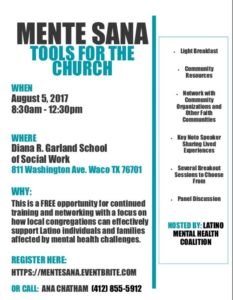 The success of the conference provided an impetus to continue this important work among the Latino community through the coalition. We have provided additional training in the churches around mental health first aid, suicide awareness and prevention and our local chapter of NAMI has presented support information for families who care for individuals with mental health issues. We also identified the need for Spanish speaking counselors and have developed a presentation to recruit Latino college students into the counseling profession. AND on August 5, 2017 at Baylor University’s Diana R. Garland School of Social Work the coalition will host the 2nd annual “Mente Sana: Tools for the Church.” We are excited to continue this important conversation with a panel, workshops and a keynote speaker. To register for the conference which is free of charge go to https://mentesana.eventbrite.com.
The success of the conference provided an impetus to continue this important work among the Latino community through the coalition. We have provided additional training in the churches around mental health first aid, suicide awareness and prevention and our local chapter of NAMI has presented support information for families who care for individuals with mental health issues. We also identified the need for Spanish speaking counselors and have developed a presentation to recruit Latino college students into the counseling profession. AND on August 5, 2017 at Baylor University’s Diana R. Garland School of Social Work the coalition will host the 2nd annual “Mente Sana: Tools for the Church.” We are excited to continue this important conversation with a panel, workshops and a keynote speaker. To register for the conference which is free of charge go to https://mentesana.eventbrite.com.
Growing up in El Paso, TX, my family and I had the distinct pleasure of living on the border and within sight of Juarez, Mexico. We took many trips to Juarez especially when family from other parts of the country visited to experience the culture and traditions of our sister city. The marketplace and the grocery store where you could buy the best hard rolls was always a hit. The other opportunity for me to experience the rich Latino culture was spending time with my best friend and her family. I made it a point to show up at her house at dinner time so that I could partake in a regular staple of their family meals, homemade tortillas! There is nothing like a homemade tortilla and if you have never experienced one you are truly missing out. What was unique about her family was their strong cultural identification that included numerous family celebrations and their honor to the matriarch in the family, her grandmother. I remember the grandmother as being a tiny woman with a soft voice who could silence a room with her words. She only spoke Spanish so I did not know exactly what she was saying but understood that it was important and that you had to listen. The love and support that existed within this large extended family was something to envy. This family stood by one another no matter what. Their faith community was also an integral part of their living and Sundays in this family was an all-day affair. When a family member experienced a problem the rest of the family gathered and provided assistance or called in the priest to provide direction. However, in looking back I can see how major difficulties were handled in isolation because one simply did not take problems outside of the family. It is through the coalition that we hope equip pastors and church leaders to encourage families to reach outside for help when needed.
 Elizabeth (Bethie) Timmons is a Licensed Clinical Social Worker and the Director of Clinical Services at HOTRMHMR. She has lived in Waco for 32 years and has been involved in a variety of capacities with the children and families of McLennan County, providing therapy and support. Her specialty includes trauma and mental health issues.
Elizabeth (Bethie) Timmons is a Licensed Clinical Social Worker and the Director of Clinical Services at HOTRMHMR. She has lived in Waco for 32 years and has been involved in a variety of capacities with the children and families of McLennan County, providing therapy and support. Her specialty includes trauma and mental health issues.
The Act Locally Waco blog publishes posts with a connection to these aspirations for Waco. If you are interested in writing for the Act Locally Waco Blog, please email ashleyt@actlocallywaco.org for more information.
By Katie Schaeffer
Jimmy Dorrell, CEO at Mission Waco, believes that “creation care” is not a side bar issue, but rather, “Christian justice demands that the creation must be protected, because every thing and every person is made in the image of God.” That is why he has worked tirelessly to put together Mission Waco’s Urban REAP (Renewable Energy & Agriculture Project). The project has commercial composting, rainwater harvesting and purification, solar power, an aquaponics greenhouse, raised grow beds, and a small training center for groups to come learn as a part of Mission Waco’s effort to be about “creation care.”
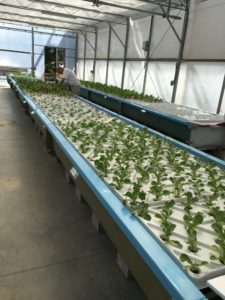 The passion Jimmy has about the privilege and responsibility God has given mankind to care for and harness his good gift of creation, and not abuse it for personal gain is based on the cultural mandate found in Gen 1:28, where he believes we receive God’s expectation that everyone should be good stewards of creation. Jimmy was also profoundly influenced in this area by the teaching of theologian Francis Schaeffer, who among many things, wrote Pollution and the Death of Man (1970). Jimmy recently posted on Urban REAP’s facebook page, a quote from the book, in which Schaeffer suggests that many in the church need an ecological conversion, “lamenting that much of evangelical Christianity had adopted a dualistic view of the world that did not take nature seriously.” He posted “For Francis Schaeffer, our shared finiteness created a bond of common grace with the rest of creation that calls for responses of stewardship, regardless of one’s religious worldview.” In another post, Jimmy expresses why creation care is so important, “Statistics profoundly show global deterioration of God’s perfect ecology that affect basics of food, water, land and weather”. He hopes that Mission Waco’s efforts in addressing these issues, will encourage individuals and corporations in Waco and the country to think about their impact on our ecology and what changes they can make to be better stewards of God’s great gift.
The passion Jimmy has about the privilege and responsibility God has given mankind to care for and harness his good gift of creation, and not abuse it for personal gain is based on the cultural mandate found in Gen 1:28, where he believes we receive God’s expectation that everyone should be good stewards of creation. Jimmy was also profoundly influenced in this area by the teaching of theologian Francis Schaeffer, who among many things, wrote Pollution and the Death of Man (1970). Jimmy recently posted on Urban REAP’s facebook page, a quote from the book, in which Schaeffer suggests that many in the church need an ecological conversion, “lamenting that much of evangelical Christianity had adopted a dualistic view of the world that did not take nature seriously.” He posted “For Francis Schaeffer, our shared finiteness created a bond of common grace with the rest of creation that calls for responses of stewardship, regardless of one’s religious worldview.” In another post, Jimmy expresses why creation care is so important, “Statistics profoundly show global deterioration of God’s perfect ecology that affect basics of food, water, land and weather”. He hopes that Mission Waco’s efforts in addressing these issues, will encourage individuals and corporations in Waco and the country to think about their impact on our ecology and what changes they can make to be better stewards of God’s great gift.
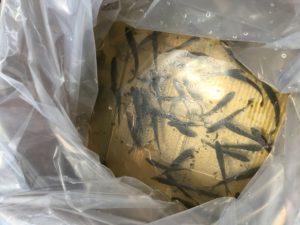 Ground breaking for the Urban REAP project, which was funded mostly through a generous grant from Green Mountain Energy Sun Club, began on January 18th, 2017. Every month since has seen the anticipated additions of the project come together. Just this week, 315 Hybrid Striped Bass fingerlings were added to the aquaponics system, which will provide organic produce to Jubilee Market, and up to 500 lbs of fish and 720 pounds of crawfish annually. Next week the commercial composter arrives which will turn biodegradable waste from Jubilee market, local restaurants and businesses into compost. This compost will be available for purchase at the upcoming greenhouse nursery behind Jubilee Market.
Ground breaking for the Urban REAP project, which was funded mostly through a generous grant from Green Mountain Energy Sun Club, began on January 18th, 2017. Every month since has seen the anticipated additions of the project come together. Just this week, 315 Hybrid Striped Bass fingerlings were added to the aquaponics system, which will provide organic produce to Jubilee Market, and up to 500 lbs of fish and 720 pounds of crawfish annually. Next week the commercial composter arrives which will turn biodegradable waste from Jubilee market, local restaurants and businesses into compost. This compost will be available for purchase at the upcoming greenhouse nursery behind Jubilee Market.
 Come see and learn about all of these developments at Urban REAP’s Grand Opening on August 22nd from 10am-12pm. Those who can’t make it are always welcome to drop by for a quick tour and sign up to be a volunteer! All this news and much more can be found on Urban REAP’s Facebook page: mwurbanreap, and Mission Waco’s website.
Come see and learn about all of these developments at Urban REAP’s Grand Opening on August 22nd from 10am-12pm. Those who can’t make it are always welcome to drop by for a quick tour and sign up to be a volunteer! All this news and much more can be found on Urban REAP’s Facebook page: mwurbanreap, and Mission Waco’s website.
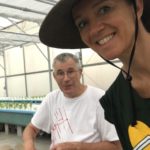 Katie Schaeffer and her husband Rick consider it a real privilege to be managing Mission Waco’s amazing Renewable Energy Agricultural Project (REAP). Katie and Rick came to Waco at the end of 2015, from CA. This week they are moving into a house they have been renovating, just a few blocks from Mission Waco and are really looking forward to being part of the neighborhood community. Katie is happiest being in nature and tending to plants, and eating good food with friends and family. She and her husband Rick are also grateful for the privilege and deep joy of raising two sets of twin boys, who are now amazing 23 & 24 year old men. That is Tony in the photo with Katie. He is her “angel” volunteer who is there everyday she is, and the reason the aquaponics greenhouse is so beautiful and well run.
Katie Schaeffer and her husband Rick consider it a real privilege to be managing Mission Waco’s amazing Renewable Energy Agricultural Project (REAP). Katie and Rick came to Waco at the end of 2015, from CA. This week they are moving into a house they have been renovating, just a few blocks from Mission Waco and are really looking forward to being part of the neighborhood community. Katie is happiest being in nature and tending to plants, and eating good food with friends and family. She and her husband Rick are also grateful for the privilege and deep joy of raising two sets of twin boys, who are now amazing 23 & 24 year old men. That is Tony in the photo with Katie. He is her “angel” volunteer who is there everyday she is, and the reason the aquaponics greenhouse is so beautiful and well run.
The Act Locally Waco blog publishes posts with a connection to these aspirations for Waco. If you are interested in writing for the Act Locally Waco Blog, please email ashleyt@actlocallywaco.org for more information.
.
(A follow-up to https://actlocallywaco.org/2016/07/19/service-learning-at-indian-spring-helping-kids-learn-to-be-citizens/)
By Travis Cheatham
Last July I wrote a blog about what service learning looks like at Indian Spring Middle School (ISMS). I explained the structure, the value, and the potential of the program. Today I write about the rewards, challenges, and opportunities of this last year through a few stories. (Names have been changed to protect student identities)
Rewards
Ava is a good student in class but she’s the queen of eye rolling. Throughout the year, I frequently had to coax Ava to get to her service learning group, which ironically she liked, but for some reason, she frequently dawdled in attending. This, by the way, is a common theme among students and is really a fact of life for middle schoolers.
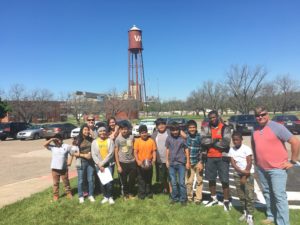 In March, our school planned an event with the VA Medical Center thanks to funds from The Meadows Foundation. Our students decided to use the funds to donate plants, games, and activities for VA residents. Ava was sure to help out with all of the last minute preparations and came to the event on a Saturday morning, no less. The following Monday morning, I was poised at the school’s main entrance to greet students (as I usually do) and Ava came running up to tell me how great a time she had. She then asked if there was any way that she could go back on her own to meet with residents.
In March, our school planned an event with the VA Medical Center thanks to funds from The Meadows Foundation. Our students decided to use the funds to donate plants, games, and activities for VA residents. Ava was sure to help out with all of the last minute preparations and came to the event on a Saturday morning, no less. The following Monday morning, I was poised at the school’s main entrance to greet students (as I usually do) and Ava came running up to tell me how great a time she had. She then asked if there was any way that she could go back on her own to meet with residents.
The lesson: Are you sharing power with your child, mentee, or student? They will relish it and will thrive. I never see our students more fulfilled at school than when they are given a task to perform. Our students have power, talent, and desire, but we have to activate it. In this next year, I hope to have more opportunities to empower our students.
Challenges
“Everyone knows service learning is boring; you’re wasting your time.” This was a common greeting from Tim as I corralled students to get to their service learning groups. I’d love to say that Tim was alone in this belief, but he wasn’t. Last year, our goal was to place all 6th and 7th graders in a service learning group based on surveys of their interests. By the time students met in their first service learning group many were confused about why they were there (even though I spent a week prepping the students).
Although middle schoolers’ decisions are inherently confusing (even to themselves), forcing students to go to something that they have no stake in is an act in vain. With no grades or requirements, our program really depended on a good hook for students’ interest and sometimes the gradual development of interest.
The lesson: This next year students will attend a service learning fair and sign up for any groups they are interested in. If they’re not interested there will be no arm twisting, but we will require students to at least take a look at their options.
Opportunities
“Hey Mike, I’m just calling to …let you know we need to cancel tomorrow due to ______
…remind you that I need you to turn in paperwork for last week’s outline
…apologize for the delay in setting up the field trip, could you do it on …”
The lesson: Although program flexibility is great, universal policies make for a well-oiled machine. As I look at the future sustainability of the service learning program I need to refine a model that can be easily administered and replicated.
How can you help?
Become a facilitator! Facilitators meet with students 1-2 hours once a week throughout the school year to guide the students in developing service projects. This year we hope to use your passions as a volunteer as the springboard for connecting students. Training will start mid-August and the program should start mid-September.
One More Good Story
Every month throughout the school year I would hold a roundtable meeting for all of our service learning facilitators to talk about upcoming events, how things were going, and to provide ongoing training. My favorite part: listening.
I’m under no delusion that I am a master of anything; do you want to know the good news for volunteers? You don’t have to be either! In those discussions, even our facilitators who were not veterans of the program contributed in a way that generated new ideas for the whole group. Those sessions produced innovative and self-critical observations which are essential for fostering real growth both individually and as a program. I am incredibly thankful for the work of my awesome volunteers and cheerleaders of this program.
Not ready to jump in? Give me a call or email and I’ll let you know about other ways to get connected at ISMS. You can also visit our website at http://indianspring.wacoisd.org/cms/One.aspx?portalId=13246&pageId=424889
to learn more about our service learning program or http://www.prosperwaco.org/mentor-coalition/ to see other ways you can mentor students in Central Texas.
 Travis Cheatham is the Service Learning Manager for Indian Spring Middle School. Before ISMS, Travis was the Executive Assistant at Mission Waco and helped lead a culinary class with the MPowerment job development program. Travis is also the Chef/Owner of Cuppa, Waco, TX a catering and food consulting business that was a regular at the farmers market in 2015. Travis is a ’06 Baylor grad who loves this community and loves to travel with his wife, Amy, whenever possible.
Travis Cheatham is the Service Learning Manager for Indian Spring Middle School. Before ISMS, Travis was the Executive Assistant at Mission Waco and helped lead a culinary class with the MPowerment job development program. Travis is also the Chef/Owner of Cuppa, Waco, TX a catering and food consulting business that was a regular at the farmers market in 2015. Travis is a ’06 Baylor grad who loves this community and loves to travel with his wife, Amy, whenever possible.
The Act Locally Waco blog publishes posts with a connection to these aspirations for Waco. If you are interested in writing for the Act Locally Waco Blog, please email ashleyt@actlocallywaco.org for more information.
